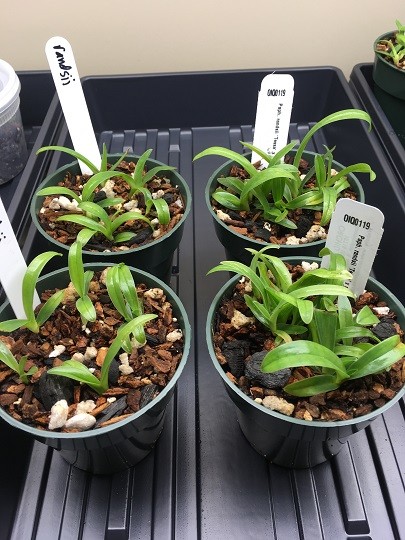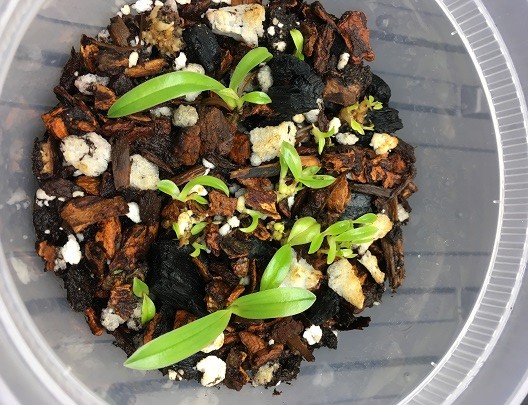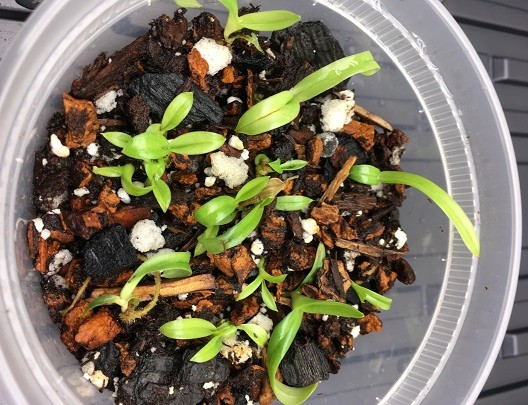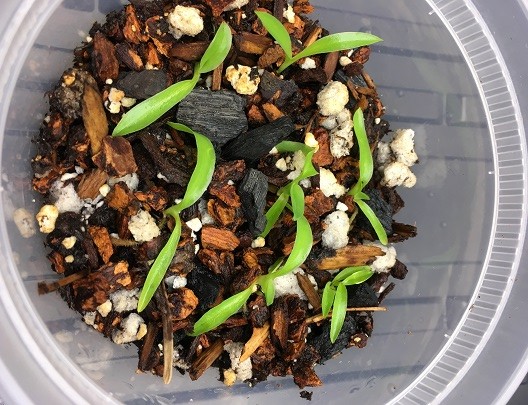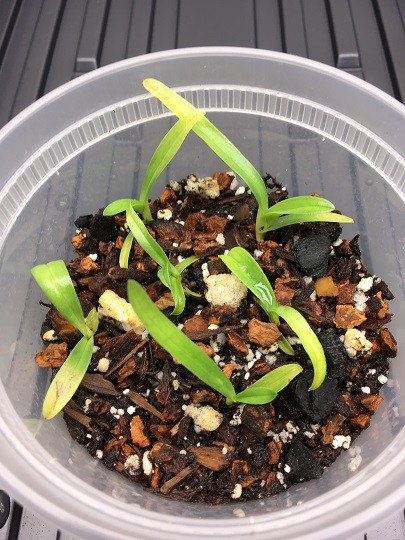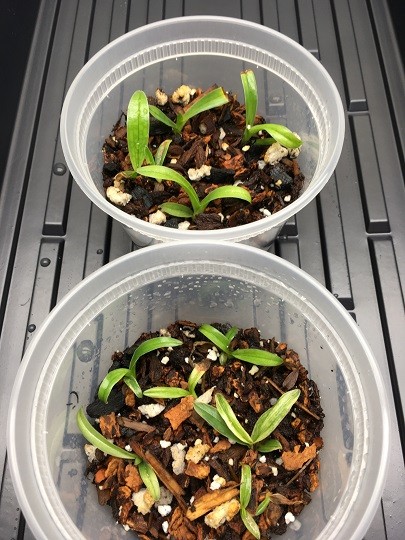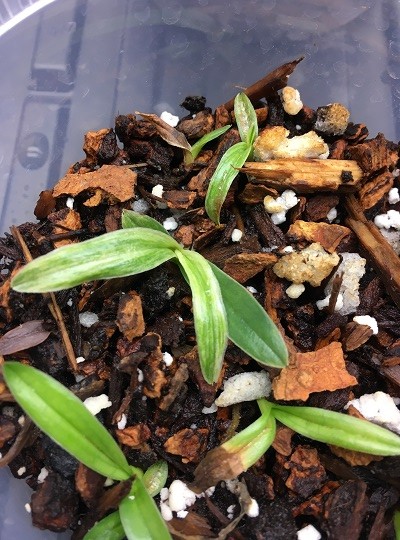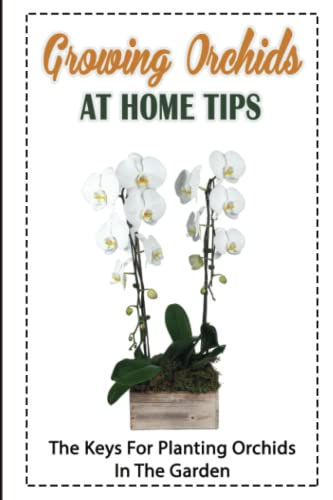The Coryopedilum Chronicles V – One month status review
This Chronicle documents the status of 2 flasks each of Paphiopedilum sanderianum, rothschildianum, platyphyllum, adductum v. anitum and randsii one month after they were deflasked and placed into compots. It presents not only the relative progress of each species but also a look at how the plants have fared in compots with and without agar intact as well as the “hospital compots” of very small seedlings that were placed in partially enclosed containers.
The status of each species is presented in a separate section, along with photographs, with the hospital compots covered separately following the species sections.
Growing conditions
The compots are all together on a single shelf in a windowless bathroom- so no natural light. Artificial light is provided by four Phillips T8 32W 48” Natural Light bulbs, 2850 lumens, 5000k bulbs that are approximately 18 inches above the leaves.
The compots are hand watered with RO water 4 times a week, and heavily misted every day. One modification that has evolved in this schedule is that the adductum v. anitum and randsii receive an extra round of watering during the hand watering cycle plus sufficiently intense daily misting to ensure water penetrates the upper half inch of the growing mix. More on why below in the status reviews for each species.
No fertilizers or other supplements have been applied, but the former will come into use in the next couple of weeks.
Temperature and humidity are monitored on an ongoing basis. Ambient temperature in the home is kept at 70 degrees, but in the immediate growing area the temperature is very consistently at a low of 72 overnight and a high of 75 during the day.
Humidity fluctuates between a low of 53-55 degrees during the day and a high of 63-65 degrees at night.
The hospital compots are kept on the same growing shelf and never fully watered- but rather heavily misted 4-5 days a week. Each is covered with a lid that has a large flap cut and pulled back for an opening of about 0.5 x 0.75 inches. The lids are left off completely the first 30 minutes after misting to allow excess water accumulation in the leaves to partially evaporate.
Daily monitoring of plant condition
As you all know, most orchid species- and Paphiopedilums in particular- are not exactly fast growers right out of flask. They can also take a few days to register their pleasure or displeasure with certain aspects of your growing conditions.
But over time I have found one effective way to get a good daily general indicator of how things are going. It is simply this- with one finger, gently stroke the underside of a leaf until you reach the leaf’s end. Paphiopedilums fresh out of flask will be quite tender for some weeks, and the translucence and firmness of the leaves will vary dramatically- and very quickly- if the plants are not receiving light and water within acceptable ranges. This simple touch test will, over time as you observe these fluctuations, be a very good way to catch problematic growing conditions early on and deal with them. The leaves should feel slightly springy and never limp- and you should not be able to see your finger through the leaves aside from possibly a slight shadow.
And one tip- please be sure your finger is completely dry when performing this test. Even a little moisture on your finger can cause the leaf to stick slightly, and then you risk disturbing or fully pulling the plant out of its place in the compot.
Here is how it looks,
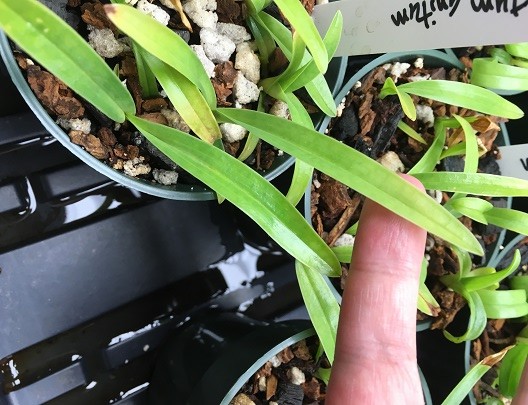
Plant losses defined
One of the statistics reported below in each section is plant loss. Please know that I define a “plant” as having at least two leaves and at least one good root. In any flask, you will always lose some or all of the really tiny plants that have not rooted well. And so I am not including them in the reported plant losses.
Paphiopedilum sanderianum
I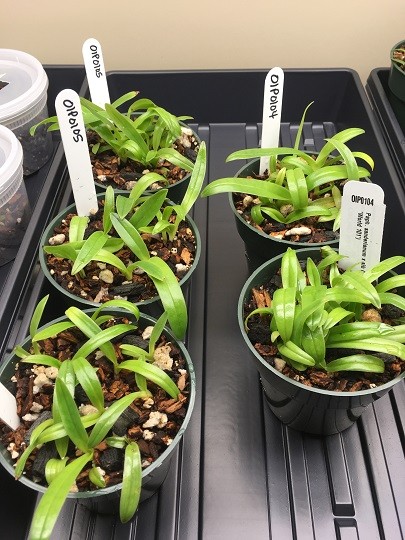
The three compots that were potted with the agar removed are on the left, and the two with agar partially intact are on the right.
Even in the very first Chronicle series I did a decade ago, sanderianum was not as difficult as I had feared, but these plants are a dream come true. They showed no shock after deflasking and very quickly fattened up and started growing. They have grown noticeably in the past month and are doing great.
There has been no noticeable difference in the performance of plants with agar versus without.
There have been no plant losses.
Paphiopedilum rothschildianum
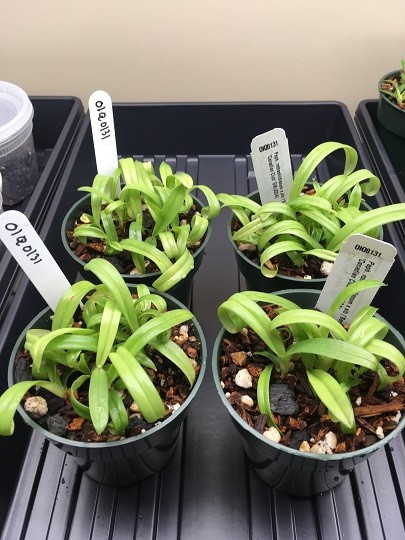
The two compots that were potted with the agar removed are on the left (they were fairly clumped in flask and so not individually separated- hence two compots vs three), and the two with agar partially intact are on the right.
These were very pale in color out of flask and did not undergo any visible shock after compotting, but they remain somewhat pale and are slowly darkening to a more ideal color. Rothschildianum has had a role in all my past Chronicles series and is usually the most vigorous out of flask. These are growing, but have not taken off in the same manner as sanderianum this time. However, I do expect that will come in the next few weeks as they fully adapt.
There has been no noticeable difference in the performance of plants with agar versus without.
There have been no plant losses.
Paphiopedilum platyphyllum
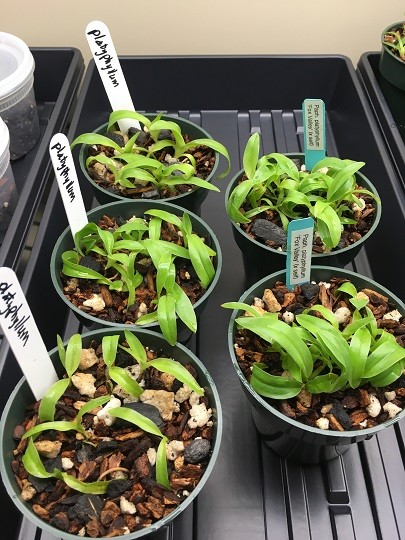
The three compots that were potted with the agar removed are on the left, and the two with agar partially intact are on the right.
This is my first encounter with this species and so far they have been worry-free. They came out of flask with a beautiful grass green color and pristine foliage- and remain in that state now. No visible post-flask shock. They are growing slowly, but already noticeably, and so far so good. The only thing to watch for with these is in the watering process. The leaves tend to curl down at the ends, and so it was not always easy to get these potted as deeply as I would like- and a few of them have needed gentle replacement when the crowns rise too high during watering. The compot in front is composed of very small plants which are doing quite well out in the open despite their meager appearance compared to the other compots.
There has been no noticeable difference in the performance of plants with agar versus without.
There have been no plant losses.
Paphiopedilum adductum v. anitum
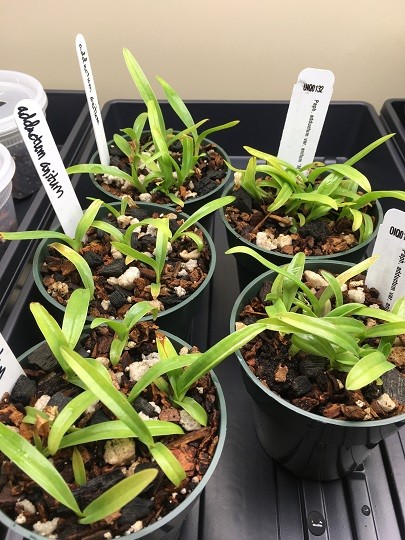
The three compots that were potted with the agar removed are on the left, and the two with agar partially intact are on the right.
So far you have read glowing reports of a trouble-free experience. Well, now things get a little more complicated. Out of flask these plants were very pale with many leaves tending toward yellow, and I was quite nervous. On my computer monitor the photo is a bit light- these are generally more grass green in color- but the leaves that were heavily yellowed out of flask continue to be so and are very slowly dying.
The good news is that the healthier and newer leaves out of flask have grown nicely in length, and most of the plants have new leaves starting in the crowns. The plants are- like the rothschildianum- slowly, but surely, adapting a healthier color with the passage of time.
This is only the second time I have worked with adductum. The first time did not go well- the plants got very limp out of flask and took a very long time to recover. This time around I have watered them more vigorously as noted above in the intro, and that seems to be making all the difference. These plants like lots of water, and with great frequency. Even on non-watering days, when I mist them I apply enough misting to ensure the surface of the growing media gets thoroughly wet with some water dripping down into the upper portion of the compots.
As the photo shows- the plants with agar removed are doing better than the plants where I left the agar partially intact. The compots with agar partially intact are slowly developing better color and starting to grow- but at a slower rate than the compots with no agar intact. I suspect this has to do with water- the presence of the agar reduces water contact. I have left them for now so that I could report the results of both compotting methods in this update, but I plan to remove the agar from the compots on the right and repot them within the next week.
There have been three plant losses. All three plant losses came from the compots with agar partially intact. In all instances they were extremely small plants that rotted at the crown (a very unusual occurrence in my experience). At this time, no additional plants appear to be in immediate danger.
This Chronicle documents the status of 2 flasks each of Paphiopedilum sanderianum, rothschildianum, platyphyllum, adductum v. anitum and randsii one month after they were deflasked and placed into compots. It presents not only the relative progress of each species but also a look at how the plants have fared in compots with and without agar intact as well as the “hospital compots” of very small seedlings that were placed in partially enclosed containers.
The status of each species is presented in a separate section, along with photographs, with the hospital compots covered separately following the species sections.
Growing conditions
The compots are all together on a single shelf in a windowless bathroom- so no natural light. Artificial light is provided by four Phillips T8 32W 48” Natural Light bulbs, 2850 lumens, 5000k bulbs that are approximately 18 inches above the leaves.
The compots are hand watered with RO water 4 times a week, and heavily misted every day. One modification that has evolved in this schedule is that the adductum v. anitum and randsii receive an extra round of watering during the hand watering cycle plus sufficiently intense daily misting to ensure water penetrates the upper half inch of the growing mix. More on why below in the status reviews for each species.
No fertilizers or other supplements have been applied, but the former will come into use in the next couple of weeks.
Temperature and humidity are monitored on an ongoing basis. Ambient temperature in the home is kept at 70 degrees, but in the immediate growing area the temperature is very consistently at a low of 72 overnight and a high of 75 during the day.
Humidity fluctuates between a low of 53-55 degrees during the day and a high of 63-65 degrees at night.
The hospital compots are kept on the same growing shelf and never fully watered- but rather heavily misted 4-5 days a week. Each is covered with a lid that has a large flap cut and pulled back for an opening of about 0.5 x 0.75 inches. The lids are left off completely the first 30 minutes after misting to allow excess water accumulation in the leaves to partially evaporate.
Daily monitoring of plant condition
As you all know, most orchid species- and Paphiopedilums in particular- are not exactly fast growers right out of flask. They can also take a few days to register their pleasure or displeasure with certain aspects of your growing conditions.
But over time I have found one effective way to get a good daily general indicator of how things are going. It is simply this- with one finger, gently stroke the underside of a leaf until you reach the leaf’s end. Paphiopedilums fresh out of flask will be quite tender for some weeks, and the translucence and firmness of the leaves will vary dramatically- and very quickly- if the plants are not receiving light and water within acceptable ranges. This simple touch test will, over time as you observe these fluctuations, be a very good way to catch problematic growing conditions early on and deal with them. The leaves should feel slightly springy and never limp- and you should not be able to see your finger through the leaves aside from possibly a slight shadow.
And one tip- please be sure your finger is completely dry when performing this test. Even a little moisture on your finger can cause the leaf to stick slightly, and then you risk disturbing or fully pulling the plant out of its place in the compot.
Here is how it looks,

Plant losses defined
One of the statistics reported below in each section is plant loss. Please know that I define a “plant” as having at least two leaves and at least one good root. In any flask, you will always lose some or all of the really tiny plants that have not rooted well. And so I am not including them in the reported plant losses.
Paphiopedilum sanderianum
I

The three compots that were potted with the agar removed are on the left, and the two with agar partially intact are on the right.
Even in the very first Chronicle series I did a decade ago, sanderianum was not as difficult as I had feared, but these plants are a dream come true. They showed no shock after deflasking and very quickly fattened up and started growing. They have grown noticeably in the past month and are doing great.
There has been no noticeable difference in the performance of plants with agar versus without.
There have been no plant losses.
Paphiopedilum rothschildianum

The two compots that were potted with the agar removed are on the left (they were fairly clumped in flask and so not individually separated- hence two compots vs three), and the two with agar partially intact are on the right.
These were very pale in color out of flask and did not undergo any visible shock after compotting, but they remain somewhat pale and are slowly darkening to a more ideal color. Rothschildianum has had a role in all my past Chronicles series and is usually the most vigorous out of flask. These are growing, but have not taken off in the same manner as sanderianum this time. However, I do expect that will come in the next few weeks as they fully adapt.
There has been no noticeable difference in the performance of plants with agar versus without.
There have been no plant losses.
Paphiopedilum platyphyllum

The three compots that were potted with the agar removed are on the left, and the two with agar partially intact are on the right.
This is my first encounter with this species and so far they have been worry-free. They came out of flask with a beautiful grass green color and pristine foliage- and remain in that state now. No visible post-flask shock. They are growing slowly, but already noticeably, and so far so good. The only thing to watch for with these is in the watering process. The leaves tend to curl down at the ends, and so it was not always easy to get these potted as deeply as I would like- and a few of them have needed gentle replacement when the crowns rise too high during watering. The compot in front is composed of very small plants which are doing quite well out in the open despite their meager appearance compared to the other compots.
There has been no noticeable difference in the performance of plants with agar versus without.
There have been no plant losses.
Paphiopedilum adductum v. anitum

The three compots that were potted with the agar removed are on the left, and the two with agar partially intact are on the right.
So far you have read glowing reports of a trouble-free experience. Well, now things get a little more complicated. Out of flask these plants were very pale with many leaves tending toward yellow, and I was quite nervous. On my computer monitor the photo is a bit light- these are generally more grass green in color- but the leaves that were heavily yellowed out of flask continue to be so and are very slowly dying.
The good news is that the healthier and newer leaves out of flask have grown nicely in length, and most of the plants have new leaves starting in the crowns. The plants are- like the rothschildianum- slowly, but surely, adapting a healthier color with the passage of time.
This is only the second time I have worked with adductum. The first time did not go well- the plants got very limp out of flask and took a very long time to recover. This time around I have watered them more vigorously as noted above in the intro, and that seems to be making all the difference. These plants like lots of water, and with great frequency. Even on non-watering days, when I mist them I apply enough misting to ensure the surface of the growing media gets thoroughly wet with some water dripping down into the upper portion of the compots.
As the photo shows- the plants with agar removed are doing better than the plants where I left the agar partially intact. The compots with agar partially intact are slowly developing better color and starting to grow- but at a slower rate than the compots with no agar intact. I suspect this has to do with water- the presence of the agar reduces water contact. I have left them for now so that I could report the results of both compotting methods in this update, but I plan to remove the agar from the compots on the right and repot them within the next week.
There have been three plant losses. All three plant losses came from the compots with agar partially intact. In all instances they were extremely small plants that rotted at the crown (a very unusual occurrence in my experience). At this time, no additional plants appear to be in immediate danger.





